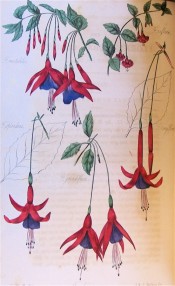Fuchsia magellanica Lam. var. grandiflora
Hardy shrub with shiny lance-shaped, toothed leaves, opposite or in whorls, and small, nodding, axillary flowers with scarlet tube and sepals and bluish-purple corolla. [RHSD. Hortus, Hilliers']. The variety grandiflora is a large-flowered form of Fuchsia magellanica. Fuchsia grandiflora as described and figured in the Floricultural Cabinet appears to be a form of Fuchsia magellanica: ‘A stiff and very compact grower, a most profuse bloomer, flowers somewhat like F. globosa, but much larger, and of a deep blood colour; its freeness in flowering, compact habits, large flowers, and rich colour, at once stamp its superiority to every other, for rooms, hot house or beds.’ [FC p.172/1835].
Horticultural & Botanical History
Fuchsia magellanica was the first fuchsia to be introduced to Europe. ‘The present plant is a native of Chili, and was introduced to the royal gardens at Kew, in the year 1788, by Capt. Firth; it takes the name of Fuchsia from Fuchs a German botanist of great celebrity. […] Every person who can boast a hot-house will be anxious to possess the fuchsia, as it is not only a plant of peculiar beauty, but produces its rich pendant blossoms through most of the summer; the petals in the center of the flower are particularly deserving of notice; they somewhat resemble a small roll of the richest purple-coloured ribband. […] Though at present from its novelty it bears a high price, yet as it is readily propagated, both by layers, cuttings, and seeds, it will soon be within the purchase of every lover of plants.’ [BM t. 97/1789].
By the 1850s there were many varieties and hybrids of Fuchsia magellanica: ‘I scarcely need to do more than just name this very charming family of flowers, as admirable bedding plants. The slender-growing kinds, such as the old F. gracilis, splendens, Thompsonia, elegans, formosa elegans, microphylla, globosa major, coccinea, bacillaris, multiflora, and similar habited ones, do the best; their wiry branches throw out the flowers to full view, and, hanging so gracefully, are admired by all beholders. Every flower garden ought to have these charming ornaments.’ [FC p.132/1850].
History at Camden Park
Listed as Fuchsia grandiflora in the 1850 and 1857 catalogues [T.481/1850]. Macarthur obtained material said to be Fuchsia grandiflora ‘Youngii’ from George Stevenson, South Australia, in early 1844. In June of that year he wrote requesting more material as ‘cuttings said to be of this last which you sent in the Spring turned out to be of the fulgens.’ [MP A2933-1, p.21]. Fuchsia magellanica Lam. var. grandiflora, which see, is probably a more likely identification of Macarthur’s Fuchsia grandiflora as Fuchsia serratifolia multiflora is listed in the 1850 catalogue. This may account for Macarthur’s comments on the plant he received from George Stevenson. Fuchsia fulgens is somewhat like serratifolia in flower, if not in leaf, and he may have been expecting a plant somewhat different to this. See also Fuchsia magellanica Lam. var. grandiflora maxima and Fuchsia serratifolia Ruiz & Pav. var. multiflora.
Notes
Published Aug 16, 2009 - 03:33 PM | Last updated Sep 01, 2011 - 04:58 PM

Fuchsia magellanica Lam. var. grandiflora | FC p.172/1835 | RBGS. Several forms of F. magellanica are illustrated, grandiflora is bottom centre.
| Family | Onagraceae |
|---|---|
| Category | |
| Region of origin | Peru to Tierra del Fuego |
| Synonyms |
|
| Common Name | Fuchsia |
| Name in the Camden Park Record | Fuchsia grandiflora
|
| Confidence level | medium |

